9 Types of Nail Guns and How to Choose
Find the right type of nail gun for your next project.
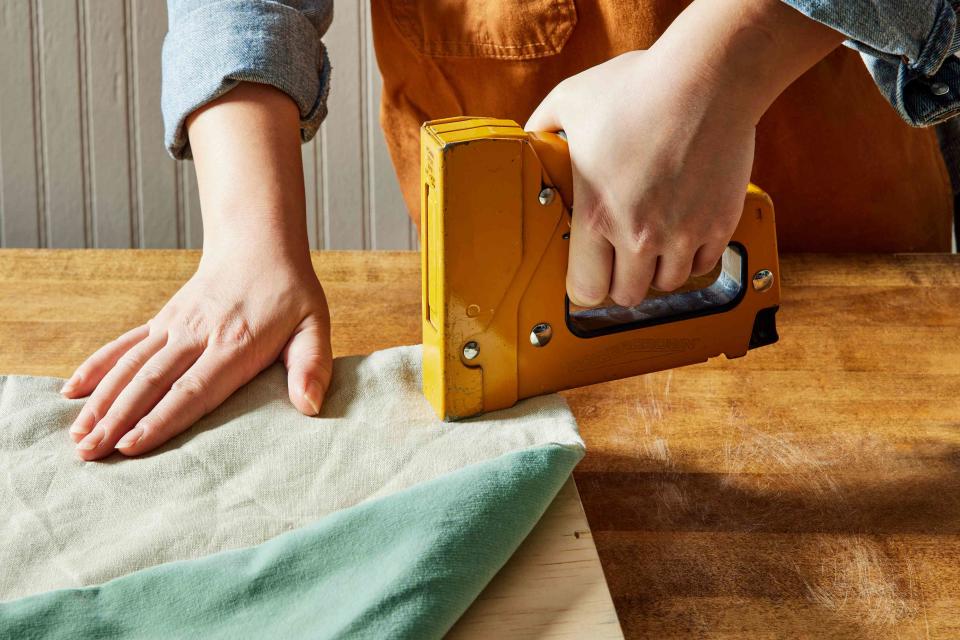
The Spruce / Kelsey Hansen
Reviewed by Johnathan Brewer
A nail gun is a power tool that is used to shoot nails into a target material, instead of having to rely on the swing of a hammer for every nail. These tools are especially useful to roofers because they can drive nails through roofing shingles at a much faster rate without causing the same fatigue and strain as a hammer. Carpenters also frequently use nail guns when they are framing or putting down a subfloor.
However, not every nail gun is suitable for every task, so it's necessary to discover more about the various types of nail gun and when they should be used. Learning the differences between each type of nail gun can help you better understand the circumstances each nail gun type is best suited to handle. Take some time to read this helpful guide to find out more about nail gun types and how to choose a nail gun for your next project.
Framing Nail Gun
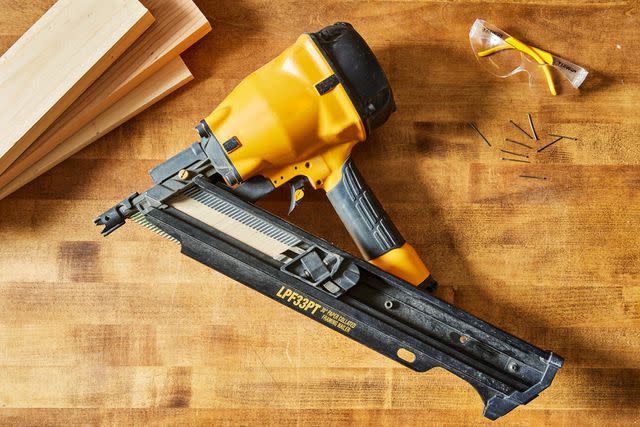
The Spruce / Kelsey Hansen
Best for: Connecting pieces of large lumber for framing, fence installation, or deck building.
A framing nail gun is a heavy-duty tool that is primarily used by carpenters to build walls by connecting large pieces of lumber together to build frames. The framing nail gun drives nails up to 3.5 inches in length and it is typically used with 2x4s or 2x6s for various carpentry projects.
Around the home, framing nail guns are great to build framework for drywall, hang fence boards, or to install a deck in the yard. Decide whether a corded, cordless, or pneumatic framing nail gun suits your purposes best. Just make sure you have an air compressor if you prefer working with a pneumatic nail gun.
Finish Nail Gun
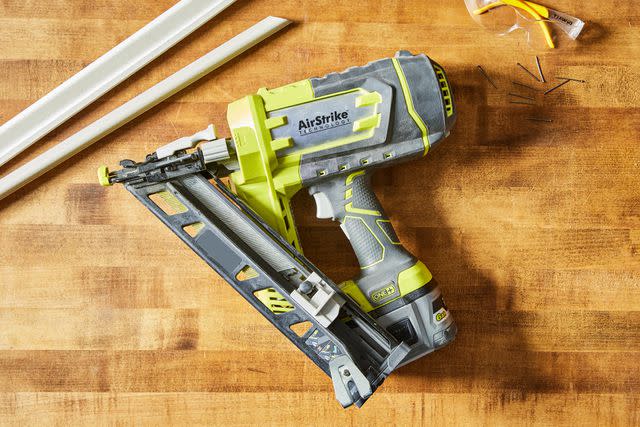
The Spruce / Kelsey Hansen
Best for: Securing trim and molding.
Finish nail guns are slightly bigger than brad nailers, allowing them to use 15 and 16 gauge nails to secure larger finishing pieces, like door trim, window trim, baseboards, and molding. Similar to other nail guns on this list, finish nailers can be corded, cordless, or pneumatic, so there are a variety of options to choose from based on personal preference.
The purpose of using a finish nail gun is that the 15 and 16 gauge nails have more holding power and withdrawal resistance than brad nails. However, these nails also leave more visible holes in the trim, requiring additional attention to properly cover the holes.
Brad Nail Gun
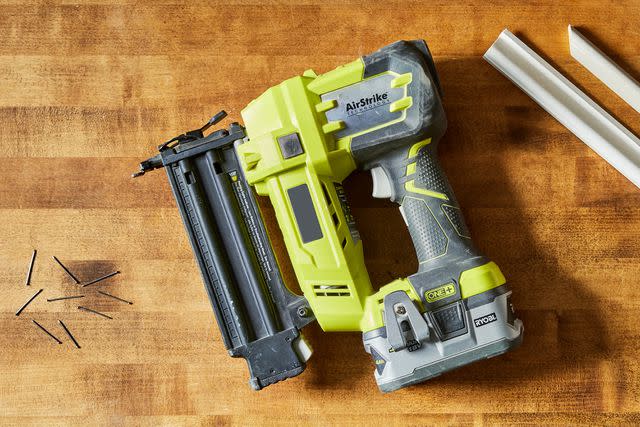
The Spruce / Kelsey Hansen
Best for: Installing trim and cabinet construction or repair.
Similar to a finish nailer, brad nail guns are typically used for installing interior trim and molding, but the fine 18-gauge nails are not suitable for larger pieces of molding. Use these tiny nails for lightweight trim or you can also use a brad nailer to secure thin wood panels to the back of cabinetry.
These light-duty nail guns are great to have around the home, especially during a painting project because you can reinstall the trim and baseboards with the nailer instead of trying to drive 18-gauge nails with a hammer. The small nails barely even leave a hole behind, making them easier to cover than the holes left behind by a finish nailer.
Siding Nail Gun
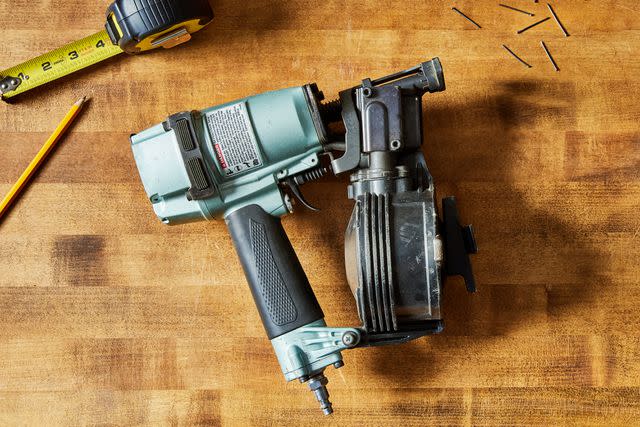
The Spruce / Kelsey Hansen
Best for: Installing siding on the exterior of homes.
As the name suggests, a siding nail gun is generally used to install pieces of siding. The nailer uses 1.5 to 2.5 inch nails to install siding. While you can use a framing nail gun to install siding, the smaller nail size and smaller magazine of a siding nailer make this tool a better option.
Additionally, siding nailers are not as heavy as framing nail guns, so you won't wear out as fast when you are using these tools. Consider where you may use a siding nail gun, then use this information to decide if it's better to have a corded, cordless, or pneumatic model.
Roofing Nail Gun
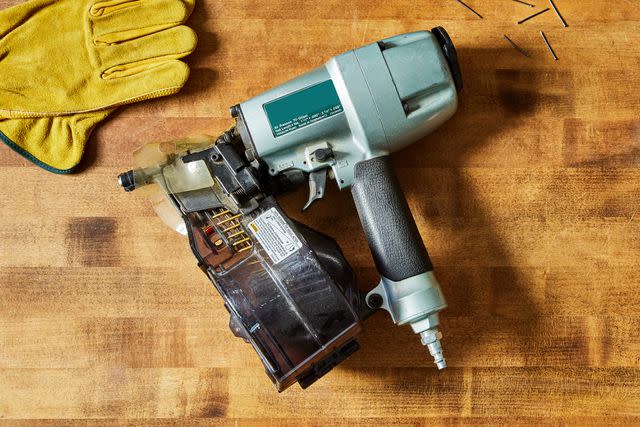
The Spruce / Kelsey Hansen
Best for: Secure roofing shingles, vinyl material, insulation boards, and fiber cement.
Roofing nail guns are versatile tools that are typically used to drive 0.75-inch to 1.75-inch nails through roofing shingles to secure them to the roof. These nailers can also be used for vinyl material, insulation boards, fiber cement, waterproof tar paper, and some thin types of siding.
While many nail guns use a magazine that orders the nails in a straight line, roofing nailers generally come with a coil or canister magazine that is able to accommodate more nails, so you spend less time reloading and more time working on the roof.
Pin Nail Guns
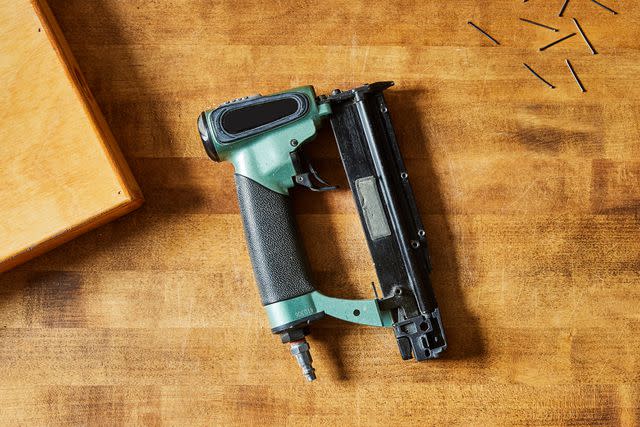
The Spruce / Kelsey Hansen
Best for: Furniture and cabinet making.
Small pin nailers use 23 gauge nails, which are so small that they resemble pins, rather than nails. These small fasteners are most appropriate for furniture and cabinet making because the tiny nails leave almost no trace behind and limit the amount of pressure put on delicate pieces of wood.
You may also want to use a pin nail gun to install narrow pieces of molding and trim, especially if a larger gauge of nail risks splitting the wood. Just keep in mind that these pins are very small and, due to the size, do not have a lot of holding strength or withdrawal resistance, so it's recommended to only use them for lightweight materials.
Palm Nail Gun
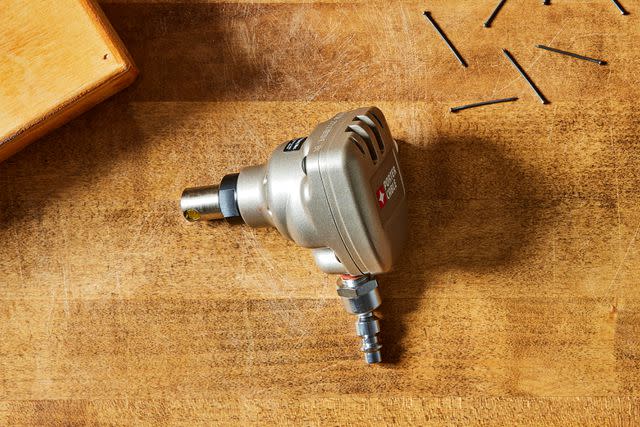
The Spruce / Kelsey Hansen
Best for: Driving nails in tight spaces.
A palm nailer is a special type of nail gun that is specifically made for driving nails in narrow spaces where a hammer or even other types of nail guns cannot fit. Instead of having a straight handle that extends vertically from the tip of the nailer, palm nailers are rounded and fit into the palm of your hand, as indicated by the name.
This short height lets them fit into tight areas, but the drawback is that the user needs to insert one nail at a time into the nail gun because it doesn't have a magazine to hold multiple nails. Though it's worth mentioning that this is a specialized tool and may not be necessary for your projects.
Hardwood Nail Gun
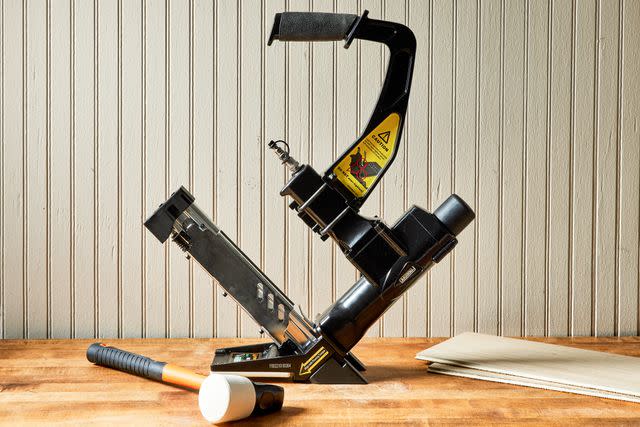
The Spruce / Kelsey Hansen
Best for: Installing hardwood flooring.
A hardwood nail gun uses a unique type of nail known as cleats. Cleats are easy to recognize because they have either an L-shaped or T-shaped head. Hardwood nail guns can be manual or pneumatic, relying on air pressure to help drive the cleats through the tough hardwood.
Unlike other nail guns, hardwood nailers require the user to hit the driver head when inserting a cleat. The amount of force required depends on the density of the hardwood being installed and the length of the cleat. As may be expected, you need to use more force when you are trying to drive longer cleats or if you are working with denser wood.
Staple Nail Gun
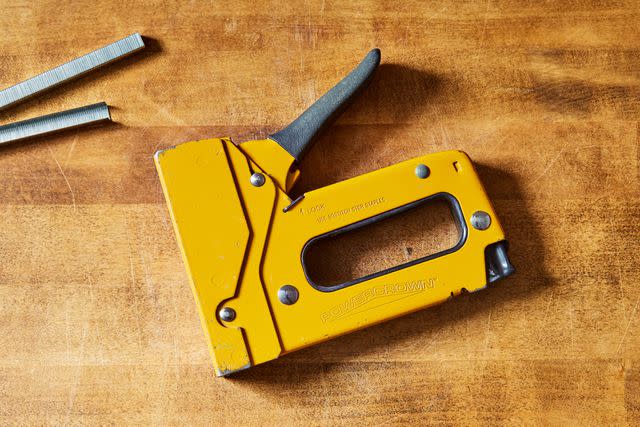
The Spruce / Kelsey Hansen
Best for: Securing upholstery to furniture, putting in carpets, and installing wood paneling.
More commonly known as a staple gun, these tools are a specialized type of nail gun that drives heavy-duty staples instead of nails. This makes these nailers ideal for upholstery repair or carpet installation because a typical nail gun nail may slip or tear through the material.
These staple guns can also be used for light-duty carpentry projects, like building a birdhouse or installing wood paneling. Additionally, with the right staples, you can use these tools to secure electrical wires to the wall, ceiling, or baseboards without damaging the wire.
Choosing a Nail Gun
When it comes to selecting a nail gun for your home workshop, you need to think about the projects that you may tackle around the home. For instance, if you typically hire contractors to repair the roof, then you won't likely need a roofing nail gun. Additionally, you should consider whether you want a corded, cordless, or pneumatic nail gun. Just keep in mind that a pneumatic nail gun requires an air compressor and a compatible hose.
If you like to take on a range of DIY products, then you may end up needing more than one nail gun. Consider investing in a staple gun for carpet installation, upholstery repair, or frame making. A framing gun is a good choice for heavy-duty nailing projects, like installing a fence or building a deck. You may also want to pick up a brad gun to have a lighter option to keep on hand to replace trim or work on wooden furniture. If necessary, choose more than one nail gun to suit your needs.
Read the original article on The Spruce.

